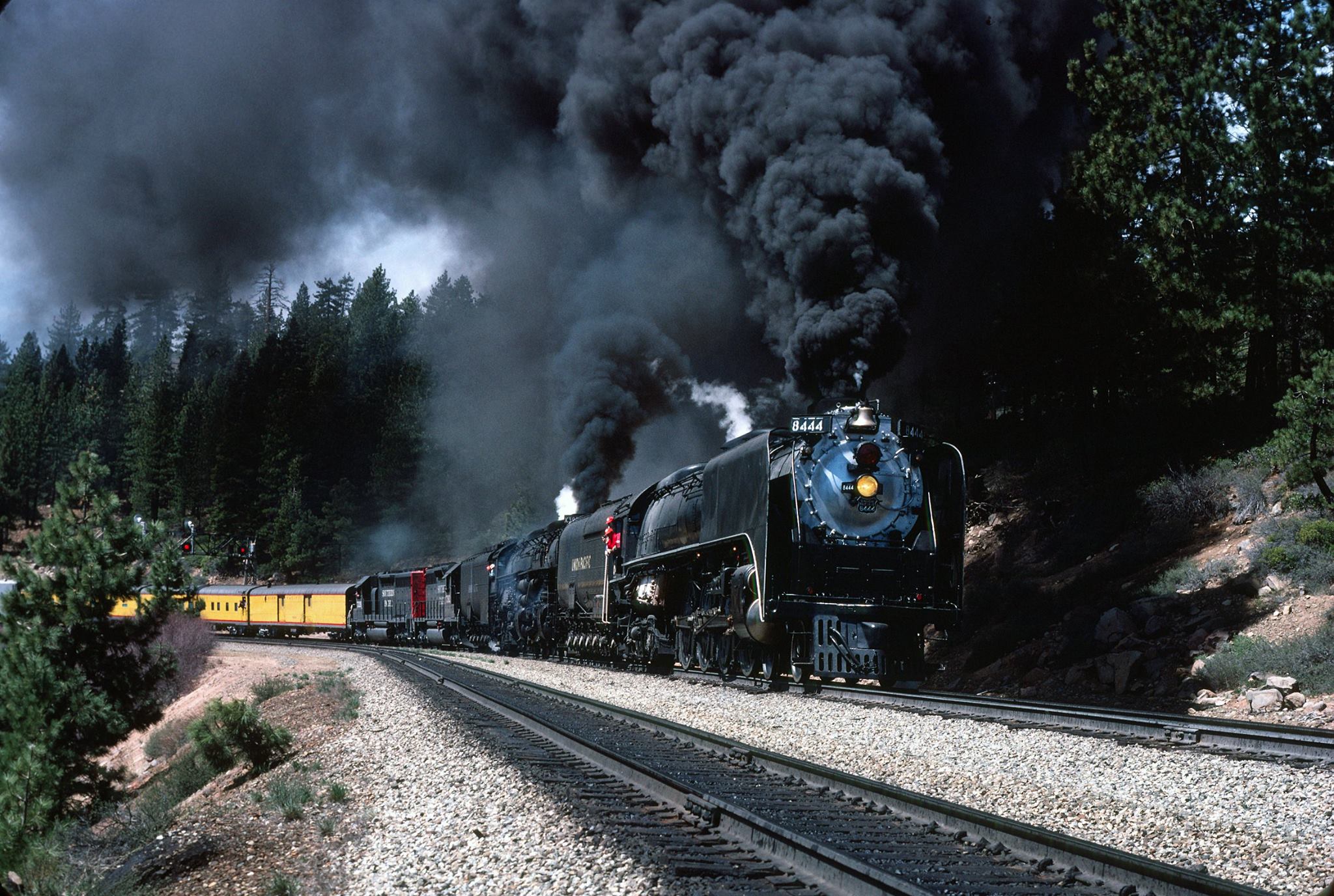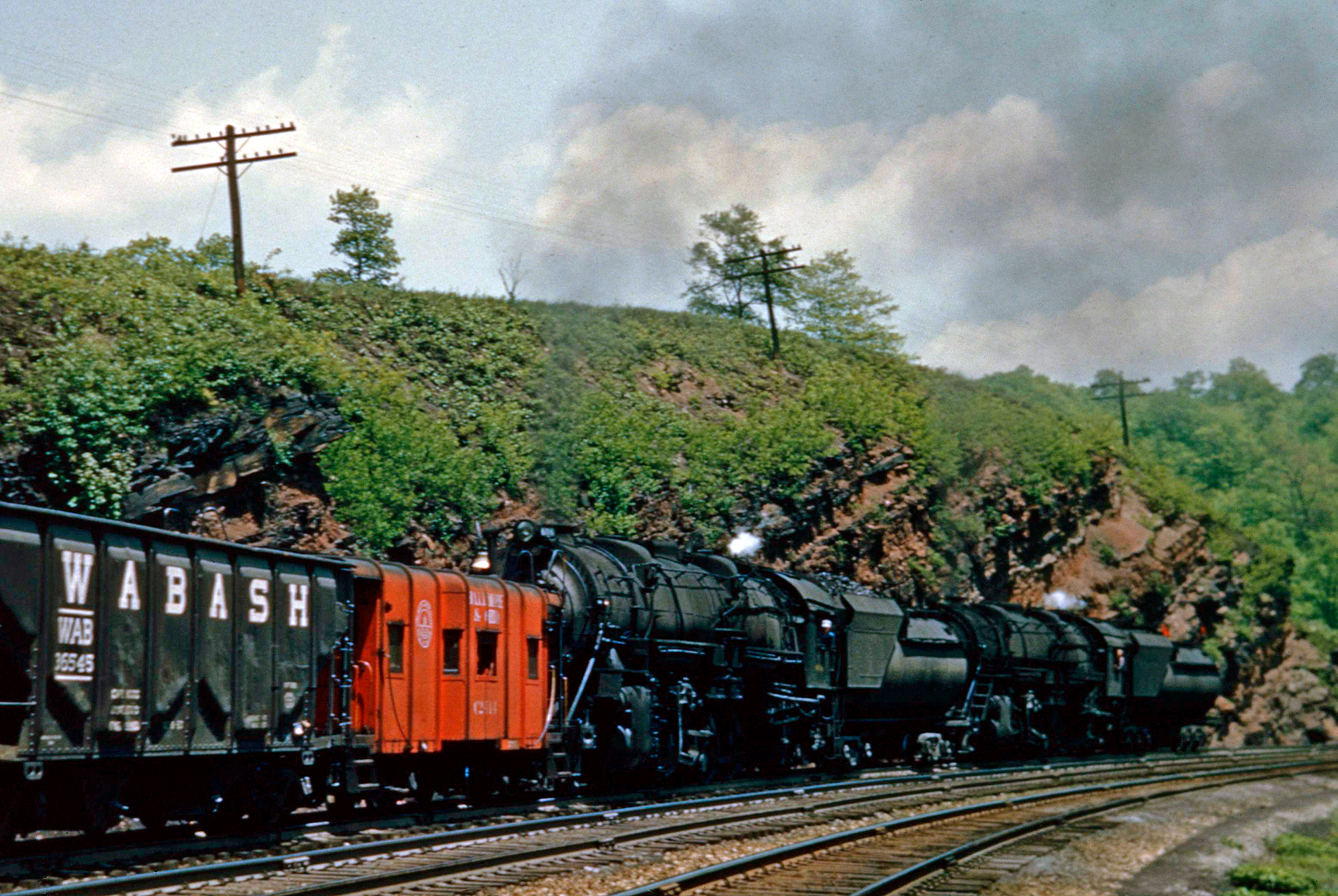The Practice of Double-Heading: The Steam Era
Published: July 1, 2024
By: Adam Burns
Double-heading, the practice of using two steam locomotives to pull a single train, was a common sight on railroads during the age of steam. This method was employed to manage heavy loads, navigate steep gradients, or improve reliability and efficiency.
Although double-heading may seem like a straightforward practice, it involved meticulous planning, coordination, and operational precision to ensure the safe and effective movement of trains. This article explores the history, technicalities, and operational details of double-heading steam locomotives.
 Union Pacific 4-8-4 #8444 and 4-6-6-4 #3985 (then still a coal-burner) charge upgrade at Cold Stream Canyon near Andover, California along Southern Pacific's Donner Pass as the big steamers double-head a special excursion to Railfair '81 during April, 1981. To give the locomotives a tougher workout the pair of trailing SD40's were put into full dynamics. Drew Jacksich photo.
Union Pacific 4-8-4 #8444 and 4-6-6-4 #3985 (then still a coal-burner) charge upgrade at Cold Stream Canyon near Andover, California along Southern Pacific's Donner Pass as the big steamers double-head a special excursion to Railfair '81 during April, 1981. To give the locomotives a tougher workout the pair of trailing SD40's were put into full dynamics. Drew Jacksich photo.Historical Context
The advent of the railway transformed transportation in the 19th and early 20th centuries. Steam locomotives, the workhorses of this new industry, were tasked with hauling increasingly larger and heavier loads as demand for passenger and freight transport grew.
Single locomotives often found it challenging to manage these burdens alone, especially on routes with steep inclines or long distances where fuel and water consumption were critical factors.
Double-heading emerged as a viable solution to these challenges. By deploying an additional locomotive at the front of the train, railroads could distribute the load more effectively, enhance traction, and ensure more reliable operation over difficult terrain.
This practice was particularly prevalent on mountainous routes, during peak traffic periods, or when particularly heavy loads needed to be transported.
Implementation
Locomotive Selection
The selection of locomotives for double-heading required careful consideration of several factors. Typically, railroads selected locomotives with similar power and speed capabilities to ensure smooth and synchronized operation.
For instance, using two locomotives of different classes with varying power outputs and speed ranges could lead to operational inefficiencies, mechanical strain, and potential safety hazards. Therefore, matching locomotives in terms of size, wheel arrangement, and tractive effort was crucial.
In some cases, railroads had dedicated locomotives for double-heading duties. These locomotives were often fitted with reinforced couplings and additional brake systems to handle the increased forces generated during double-heading operations.
Coupling the Locomotives
The process of coupling two steam locomotives involved several critical steps to ensure secure and efficient operation. The front locomotive, often referred to as the "lead" locomotive, was connected directly to the train's rolling stock. The "helper" locomotive, which provided additional power, was coupled behind the lead engine.
Communication
Communications between both crews was critical to ensure both engines were providing either the same level of power, or braking (if necessary). This was generally performed using whistle signals while seasoned crews who knew their territory could anticipate adjustment.
Finally, the PRR would utilize its own form of wireless radio with the "Trainphone" system it began testing in 1936, and which had been perfected by 1943.
 Santa Fe 4-8-2 #3743 and 4-8-4 #3783 double-head a passenger consist at Lamy, New Mexico, circa 1950. Ed Olsen photo. American-Rails.com collection.
Santa Fe 4-8-2 #3743 and 4-8-4 #3783 double-head a passenger consist at Lamy, New Mexico, circa 1950. Ed Olsen photo. American-Rails.com collection.Operational Coordination
Effective double-heading required seamless coordination between the engineers operating each locomotive. Communication and cooperation were key to maintaining consistent speed, managing power output, and ensuring safety.
1. **Starting and Stopping**: The lead engineer typically took charge of starting and stopping the train. Both engineers had to synchronize their efforts to prevent jerking motions that could damage the train or cargo. Clear communication signals, often pre-arranged before the journey, were crucial.
2. **Speed Regulation**: Maintaining a consistent speed was essential to avoid placing undue strain on the locomotives and couplings. Engineers had to constantly monitor gauges and make real-time adjustments to throttle settings and steam pressure. Communication between engineers ensured that both engines were working in harmony.
3. **Managing Grades**: One of the primary reasons for double-heading was managing steep grades. On ascending terrain, both locomotives provided maximum power to prevent stalling. On descending slopes, synchronized braking was necessary to control speed safely.
4. **Fuel and Water Management**: Steam locomotives consumed significant amounts of coal and water. Coordinating fuel stops and water refills required careful planning, as both locomotives needed to be refueled in tandem to ensure consistent performance.
5. **Emergency Protocols**: Engineers needed to be prepared for mechanical failures or emergency situations. Quick communication was vital to address issues such as steam leaks, brake failures, or unexpected obstacles on the tracks. Having predefined emergency protocols helped manage such situations effectively.
Advantages of Double-Heading
Double-heading offered several advantages that made it a valuable practice during the steam era:
1. **Increased Hauling Capacity**: By using two locomotives, railroads could haul longer and heavier trains, meeting growing demand for both passenger and freight services. This was especially important for industries reliant on bulk transportation, such as mining and agriculture.
2. **Improved Traction**: On steep gradients or slippery tracks, double-heading provided additional traction and prevented slippage. This was crucial for maintaining consistent speed and avoiding accidents.
3. **Operational Flexibility**: Double-heading allowed railroads to redistribute locomotives as needed, enhancing operational flexibility. Locomotives from neighboring depots could be brought in to assist with heavy loads during peak periods or challenging weather conditions.
4. **Safety and Reliability**: The backup power provided by a second locomotive added an extra layer of safety. In case of mechanical failure in one locomotive, the other could assist in bringing the train to a stop or even completing the journey.
Limitations and Challenges
While double-heading was advantageous, it wasn’t without its challenges and limitations:
1. **Operational Complexity**: Coordinating two locomotives and their engineers required careful planning and skilled personnel. The slightest miscommunication could lead to mechanical strain or accidents.
2. **Fuel and Resource Consumption**: Double-heading resulted in increased fuel and water consumption. Managing these resources efficiently was essential to avoid unnecessary delays and costs.
3. **Mechanical Wear and Tear**: The additional power exerted by two locomotives placed more stress on the track infrastructure, couplings, and the locomotives themselves. Regular maintenance was crucial to mitigate wear and tear.
4. **Infrastructure Requirements**: Double-heading required specific infrastructure, such as passing loops and adequately spaced sidings, to accommodate the longer trains and additional locomotives. Investing in such infrastructure was often costly.
Diesel Era
With the advent of diesel and electric locomotives in the mid-20th century, the practice of double-heading steam locomotives began to decline. Diesel and electric engines offered greater power and efficiency, often eliminating the need for multiple units to haul heavy loads.
Diesel locomotives, for instance, provided higher tractive effort and more consistent performance over long distances without the need for frequent fuel and water stops.
In addition, they could be MU'ed, or operated in tandem with the engineering controlling all of the units from the head-end. This not only offered near limitless horsepower but also required just a single crew in the lead locomotive.
 A pair of Baltimore & Ohio 2-10-2 "Big Sixes" works helper service with westbound freight near Mance, Pennsylvania on Sand Patch in May, 1951. The train was led by FA-2 #805. Bill Price photo. American-Rails.com collection.
A pair of Baltimore & Ohio 2-10-2 "Big Sixes" works helper service with westbound freight near Mance, Pennsylvania on Sand Patch in May, 1951. The train was led by FA-2 #805. Bill Price photo. American-Rails.com collection.Conclusion
The practice of double-heading steam locomotives played a vital role in the history of railway transportation. By leveraging the combined power of two locomotives, railroads could manage heavy loads, navigate challenging terrain, and ensure reliable and safe operations.
Though the advent of diesel and electric locomotives eventually rendered double-heading less common, the practice exemplified the innovative solutions developed during the steam era to tackle the growing demands and challenges of rail transportation.
Double-heading remains a testament to the ingenuity and resourcefulness of railway engineers and operators, showcasing how collaborative efforts and technical precision contributed to the evolution of modern railways.
Recent Articles
-
Oregon Railroad Museums: A Complete Guide
Apr 25, 25 03:11 PM
With its rich tapestry of scenic landscapes and profound historical significance, Oregon possesses several railroad museums that offer insights into the state’s transportation heritage. -
North Carolina Railroad Museums: A Complete Guide
Apr 25, 25 02:56 PM
Today, several museums in North Caorlina preserve its illustrious past, offering visitors a glimpse into the world of railroads with artifacts, model trains, and historic locomotives. -
New Jersey Railroad Museums: A Complete Guide
Apr 25, 25 11:48 AM
New Jersey offers a fascinating glimpse into its railroad legacy through its well-preserved museums found throughout the state.

